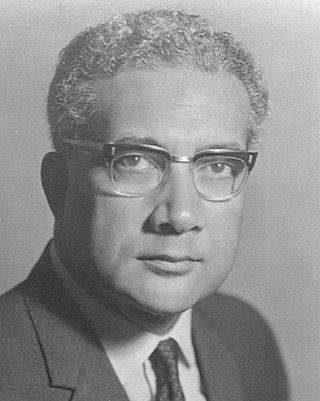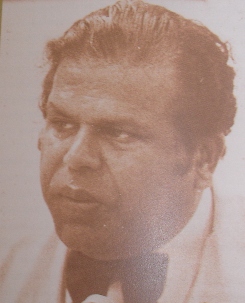1965 Constitutional Conference
When, in late 1964, when the Government announced a constitutional conference to decide on Fiji's move to independence, it asked each ethnic group to select its own delegates. A.D. Patel nominated himself and three other Federation Party members, James Madhavan, C. A. Shah (nominated Indian member who had joined the Federation Party) and S. M. Koya. It was claimed that these did not represent the Indian community and an impasse was avoided when it was decided to invite all unofficial members to the London constitutional conference. At the conference the main difference amongst the members was that while the Federation Party members asked for common roll and immediate independence, the others wanted only a minimal change to the existing constitution.
The British Government decided to introduce cross-voting as a compromise between the Fijian and European delegates on one side and the Indians on the other. According to the cross-voting system, multiracial electorates voted for candidates of different ethnic groups. The Legislative Council was enlarged to 36 members, consisting of 14 Fijians (9 elected on a communal roll, 3 on a cross-voting roll, and two nominated by the Great Council of Chiefs), 12 Indians (9 elected on a communal roll and 3 on a cross-voting roll) and 10 Europeans (7 elected on an acommunal roll and 3 on a cross-voting roll). Some of the non-contentious proposals by the Federation Party were accepted. These were the establishment of Public Service Commission, Police Service Commission, and Judicial and Legal Services Commission and a Bill of Rights.
From 1966 until the death of A.D. Patel
The outcome of the constitutional conference was a major issue during the election, which was the first election in Fiji contested on party lines. The Federation Party was expected to win at least the three cross-voting seats in the western division because of its predominantly Indian population but managed to win only the 9 Indian communal seats. The Alliance Party won 22 seats but the three independents and the two Council of Chiefs nominees joined it to give it a total strength of 27. Ratu Kamisese Mara of the Alliance Party became the Chief Minister and A.D. Patel became the Leader of the Opposition.
Ethnic tensions escalated following the adoption of responsible government in 1967, when Patel's arch-rival, the Lauan chief Ratu Kamisese Mara was appointed Chief Minister on 20 September. Mara's Alliance Party was a coalition of indigenous and European factions, with minimal Indo-Fijian participation. Patel and the NFP were consigned to the opposition benches. In protest at the new government's refusal to call a second constitutional conference, Patel led the nine Federation Party legislators in a mass walkout in September 1967.
Missing two consecutive sections of the Legislative Council resulted in the forfeit of their seats, forcing by-elections. The ensuing by-elections were marked by inter-ethnic violence. All nine Federation Party legislators were returned with increased majorities, winning 78.55% of the votes cast. A.D. Patel won by 7903 votes to 2772 for M.V. Pillay. There were demonstrations by ethnic Fijians and calls to not renew native land leases and extreme elements called for Indians to be deported from Fiji. Relations between the Indo-Fijian and indigenous communities were at a new low.
The Federation Party, represented by most of its lawyer Councillors, took up the case on behalf of the farmers when arbitration proceedings were begun on 19 August 1969 for the new cane contract. The Federation Party rejected the last cane contract, blaming it for leading the farmers deeper into debt, attacked the monopoly position of CSR, its secret accounting procedures, and concealed profits and asked for a fairer price for cane based on the price of sugar and its by-products. The Denning contract awarded the growers, 65% and the millers 35% of the proceeds of all sale, including molasses. It further guaranteed the growers a minimum price of $7.75 per ton of cane paid in two instalments. Denning commended A.D. Patel for having mastery of all the facts and problems of the sugar industry and presenting them with skill and understanding.

Ratu Sir Kamisese Mara, was a Fijian politician, who served as Chief Minister from 1967 to 1970, when Fiji gained its independence from the United Kingdom, and, apart from one brief interruption in 1987, the first Prime Minister from 1970 to 1992. He subsequently served as President from 1993 to 2000.

The Alliance Party, was the ruling political party in Fiji from 1966 to 1987. Founded in the early 1960s, its leader was Kamisese Mara, the founding father of the modern Fijian nation. Widely seen as the political vehicle of the traditional Fijian chiefs, the Alliance Party also commanded considerable support among the Europeans and other ethnic minorities, who, although comprising only 3–4% of Fiji's population, were over represented in the parliament. Indo-Fijians were less supportive, but the Fijian-European block vote kept the Alliance Party in power for more than twenty years.

Siddiq Moidin Koya was a Fijian Indian politician, Statesman and Opposition leader. He succeeded to the leadership of the mostly Indo-Fijian National Federation Party (NFP) on the death of the party's founder, A. D. Patel, in October 1969, remaining in this post until 1977. He later served a second term as leader of the NFP, from 1984 to 1987.

General elections were held in Fiji between 15 and 29 April 1972, the first since independence from the United Kingdom in 1970. They were characterised by the lack of rancour between racial groups, typical of the 1966 general election and the 1968 by-elections.

General elections were held in Fiji between 19 March and 2 April 1977. As a result of a split in the ethnic Fijian vote, the ruling Alliance Party of Prime Minister Kamisese Mara suffered a narrow defeat. Although the Alliance Party received the most votes, it won only 24 seats, two fewer than the Indo-Fijian-dominated National Federation Party (NFP). One seat was won by the Fijian Nationalist Party, with the remaining seat going to an independent candidate, Osea Gavidi.

General elections were held in Fiji between 10 and 17 July 1982. The paradoxical results were both a triumph and a setback for the Alliance Party of the Prime Minister, Kamisese Mara. The Alliance received 52% of the popular vote, only slightly down on its previous total, but won only 28 seats, eight fewer than in the previous elections of September 1977. Part of the reason for this discrepancy was that the slight surge in support for Mara's Alliance in the Indo-Fijian community, from 14 percent to 16 percent, was not sufficient to translate into seats in Fiji's communal electoral system, and did not therefore off-set losses among the ethnic Fijian community, particularly in the west of the country. The Western United Front of Osea Gavidi won only two seats, but split the vote, allowing the National Federation Party (NFP), with which it tactically allied itself, to gain seven seats for a total of 22. The NFP, which had split into two factions before the previous elections, had been reunited.

The National Federation Party is a Fijian political party founded by A.D. Patel in November 1968, as a merger of the Federation Party and the National Democratic Party. Though it claims to represent all Fiji Islanders, it is supported, in practice, almost exclusively by Indo-Fijians whose ancestors had come to Fiji between 1879 and 1916, mostly as indentured labourers. However, in the 2018 general election, the party recorded a considerable change in its support base due to the inclusion of more indigenous Fijian candidates.

Fiji's parliamentary election of March 1977 precipitated a constitutional crisis, which was the first major challenge to the country's democratic institutions since independence in 1970.
Sir Vijay Raghubar Singh, KBE was an Indo-Fijian lawyer and politician who held Cabinet office in the 1960s and 1970s. Vijay Singh served in Prime Minister Ratu Sir Kamisese Mara's government in a variety of positions, including Attorney-General, and was president of the Indian Alliance, a division of the ruling Alliance Party. He quit the party in 1979 following disagreement with Alliance leadership and later joined the opposition National Federation Party. Vijay Singh was involved in the restructure of the Fiji sugar industry and was a leading member of the Jaycees movement in Fiji.

Ambalal Dahyabhai Patel, better known as A.D. Patel, was an Indo-Fijian politician, farmers' leader and founder and leader of the National Federation Party. Patel was uncompromisingly committed to a vision of an independent Fiji, with full racial integration. He was one of the first to advocate a republic, an ideal not realized in his lifetime. He also advocated a common voters' roll and opposed the communal franchise that characterized Fijian politics.

General elections were held in Fiji between 26 September and 8 October 1966, the last before independence in 1970 and the first held under universal suffrage. The result was a victory for the Alliance Party, which won 23 of the 34 elected seats. Its leader Kamisese Mara became the country's first Chief Minister the following year.

Communal constituencies were the most durable feature of the Fijian electoral system. In communal constituencies, electors enrolled as ethnic Fijians, Indo-Fijians, Rotuman Islanders, or General electors vote for a candidate of their own respective ethnic groups, in constituencies that have been reserved by ethnicity. Other methods of choosing parliamentarians came and went, but this feature was a constant until their final abolition in the 2013 Constitution.

National constituencies were a former feature of the Fijian electoral system. They were created as a compromise between demands for universal suffrage on a common voters' roll, and for a strictly communal franchise, with Parliamentary constituencies allocated on an ethnic basis and elected only by voters enrolled as members of specific ethnic groups.

Fiji was an independent state from 1970 to 1987, a Commonwealth realm in which the British monarch, Elizabeth II, remained head of state as Queen of Fiji, represented by the Governor-General. The state was the successor of the British Colony of Fiji which was given independence in October 1970 and it survived until the Republic of Fiji was proclaimed on 6 October 1987 after two military coups, at which time Queen Elizabeth II was removed as head of state. During this time, Fiji's highest court was the Judicial Committee of the Privy Council, which was above the Supreme Court of Fiji in the Fijian judicial system.
James Shankar Singh, MBE was a Fiji Indian farmer, businessman, social worker and politician who served as a Minister in the Alliance Government of Ratu Sir Kamisese Mara. Like many Fiji Indian politicians of the era, he joined the Alliance Party with a belief in mutiracialism, but was disappointed with the Alliance Party's appeal to Fijian nationalism after 1977 and left the Alliance to join the National Federation Party.

By-elections for the nine Indo-Fijian seats in the Legislative Council were held in Fiji between 31 August and 7 September 1968. The seats had previously been held by the Federation Party, but their members had resigned in protest at the introduction of ministerial government and failure to reform the electoral system.

The National Congress of Fiji was a Fijian political party that existed from 1965 to 1967. It was created to represent Indo-Fijians as a rival to the Citizens Federation. It soon merged, along with the General Electors Association, which mainly represented Fijians of European descent, to form the Alliance Party.
Andrew Indar Narayan Deoki was an Indo-Fijian statesman who served his community as a social and religious leader, soccer administrator, member of the Legislative Council and Senate in independent Fiji and as Attorney General.
The Citizens Federation was the political expression of a predominantly Indo-Fijian trade union movement, and was a forerunner of the present day National Federation Party.





